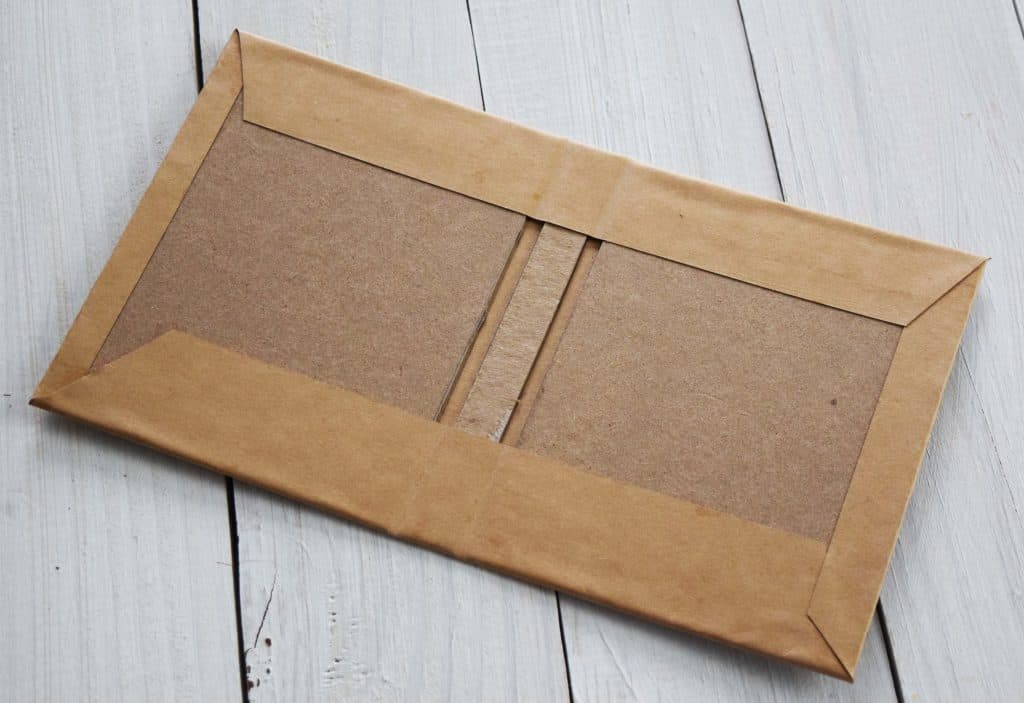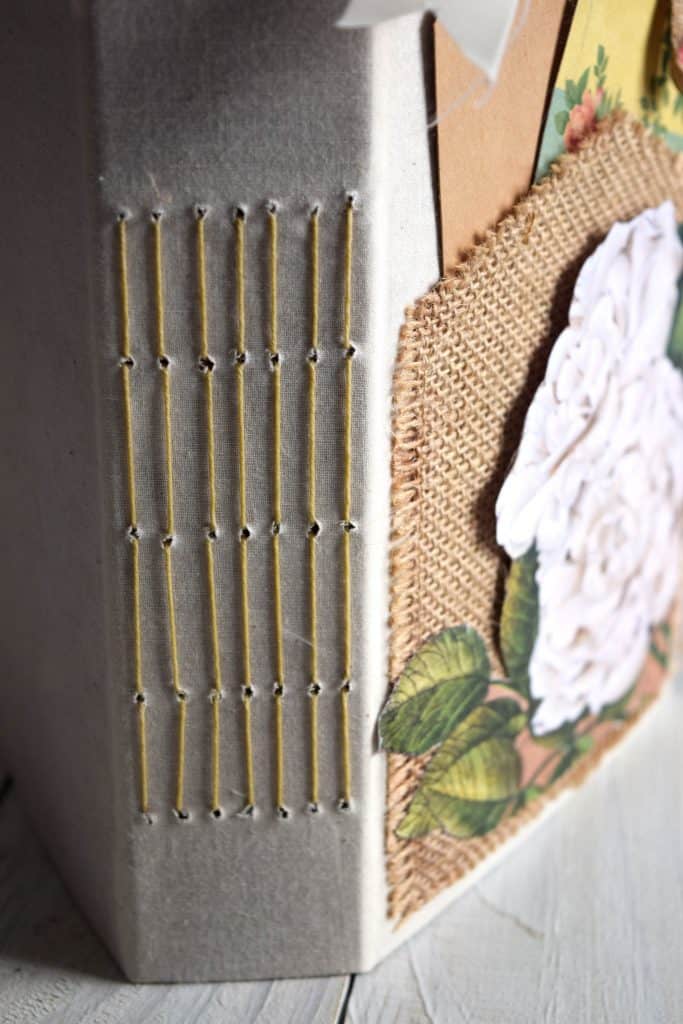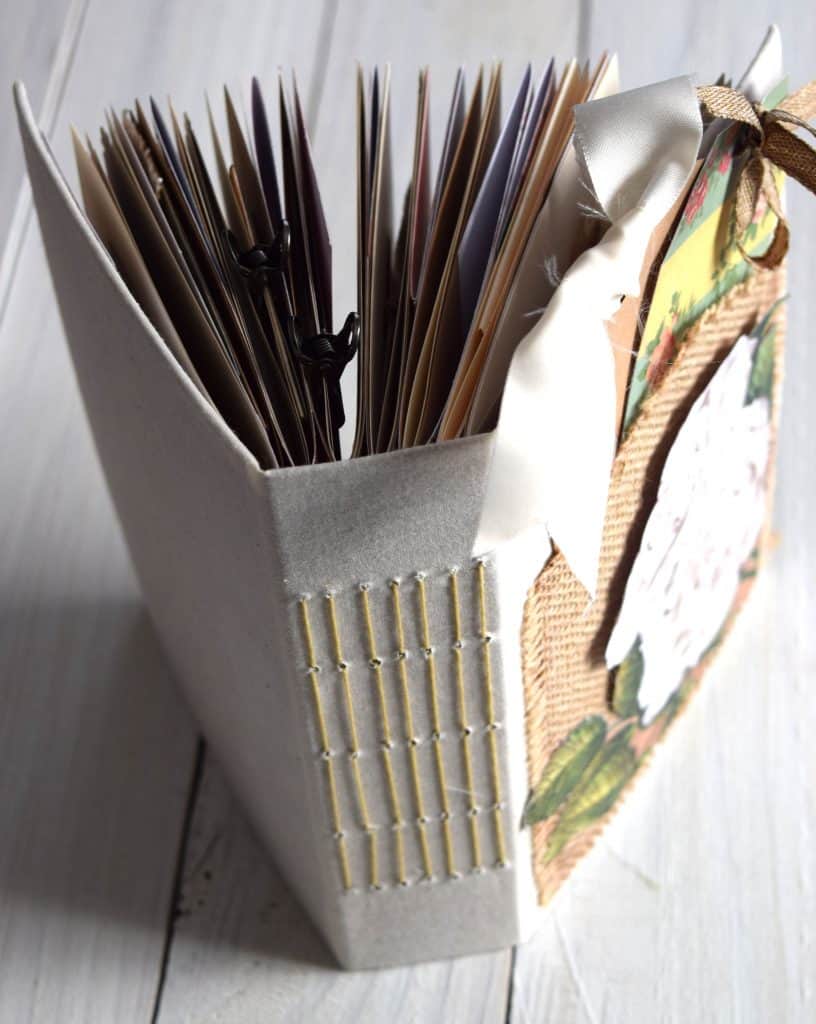What is a Junk Journal?
A junk journal is a book or journal made up of scrap pieces of paper bound together. Beyond that there are many many variations and interpretations. In fact, some people don’t even use scrap pieces of paper. The beauty of a junk journal, much like a bullet journal, is that it can be whatever you want it to be.
The most common kind of junk journal is a vintage junk journal, which are journals that use actual or imitation vintage papers to fill the pages, and are generally modified with additional artistic methods of faux-aging such as tea-dying or using oxide inks.
They’re often filled with ephemera, pockets, envelopes, flip out pages, tags and other embellishments to add to the detail of the work.
If you’re a junk journaling beginner, I recommend checking out the best supplies for junk journaling beginners to help you make sure you’ve got everything you need on hand to make a junk journal.
Transparency Note: This post contains affiliate links. That means if you choose to purchase through my links I will make a small commission through no extra charge to you. You can read more on the privacy policy and disclosure.

Gather Pages for Your Junk Journal
Junk journals are made from gathered materials. Maybe you have some old scrap paper you’re not using, or some old magazines lying around. Or perhaps you have a half-used notebook you could rip the pages out of.
If you can’t find pages you like, don’t worry. You can purchase some scrapbook paper and use that or you can use printables. There are lots of printables for sale on Etsy for exactly this purpose and we also have a guide on where to get free junk journal printables and graphics. Some are a true mish mash of different designs and colors and others have themes like roses or Jane Austen. Decide which way you want to go, and start collecting different pages and papers to use in your journal.
Once you’ve got all your pages gathered and printed, put them all together in front of you and start thinking about how you’d like them all to go together.
Creating Junk Journal Signatures
Signatures are the sections of paper that go into a book. They are typically 4 or more pages folded in half and stitched together. Start taking the paper you’ve gathered, and put it together in piles of 4 pages that look good together. (What looks good is subjective so you decide how you like it to look!)
Want an in depth tutorial on signatures? Here’s our step-by-step tutorial on how to make junk journal signatures (complete with video!)
Making a Junk Journal Cover
Altered Book
Many people in the junk journaling community use old books they own to create their covers. They simple tear out the pages of the book, and use that as their cover. Sometimes they recover it with fabric or with paper, but it helps you skip having to make the cover from scratch.
Folder
You can also use a heavy duty folder to serve as the basis for your cover. You can cover it in scrapbook paper or other decorative paper or you can vintage it up with some Tim Holtz vintage photo oxide. The folder version is one of the easiest methods because you can just stitch your signatures into it.

Hard Cover
You can also give your journal a hard cover and make it from scratch. You’ll need chipboard, decorative paper or book cloth (learn how to make book cloth), and some glue. You’ll cut the pieces of chipboard down to the size of cover and spine you’d like. Then glue the cover on, and you’ve got a hard cover for your journal.
Want a step-by-step tutorial on making your own hard cover journal? Here’s our easy guide to making a junk journal cover (with video!)
Bringing The Cover and Signatures Together into a Junk Journal
There are several different ways you can stitch a junk journal together. In fact there are probably over a dozen. For just getting started though, the easiest ways are to saddle stitch or use rings to bind your books. Ring binding is the easiest because it only takes a hole punch and rings, but saddle stitching is pretty easy as well.
Ring Bound
For ring binding you’ll need a set of rings, a hole punch and whatever you’d like to use as a cover. You can use cut up cereal boxes, the back of a pad of paper, or something else thats sturdy and thick. Punch holes in it and set that aside. Then take your signatures. For the ring binding, so things can open fully flat, you’ll want to cut at the fold and completely separate the pages. Run the rings through the holes, and you’ve created your first junk journal!
Stitch Bound
For these you’ll need waxed thread, a needle, and a book awl (or other tool to poke holes in the binding). There are a number of ways you can stitch your binding in, but two of the most popular are saddle stitch or coptic stitch.
A Note on the Spine if You Choose to Stitch
Some people choose to stitch directly into their spine and have the stitching of the binding exposed. If you get good at stitching or if you’re using a decorative stitch, this can look beautiful or just give your journal that extra bit of interest. You can also choose not to expose the stitching and wrap the entire book inside its cover.

Exposed Stitch Method
With this method, you stitch the signatures straight into the spine of the journal. This is most common with the saddle stitch. It can create a really beautiful look and some people even add special methods to their stitching that can create designs along the spine. (If you want to try this method, we’ve got a guide and video on how to stitch your junk journal.)
Cover Wrapped Method
If you prefer not to have your stitches show, there are options for that as well. You can either cover the stitches up with paper, stitch into a piece of chipboard or thick cardstock and glue the piece in, or you can create a floating spine by pasting down the outer pages of your journal to the covers. It’s completely up to you and your preferences!
Embellishing Your Junk Journal

Embellishing is the heart of junk journaling. It’s where you add your special twist with bits and bobs, flips, envelopes, even bits of jewelry. If you’re just starting out, one of the easiest ways to get started is to buy an ephemera pack. They typically come themed and contain a number of photos, decorations, lace and ribbons, die cuts, and more.
But you don’t have to start there – you can just use craft supplies you have around the house. A bit of ribbon, a few old journaling cards, some paint and some stamps? You’ve probably got everything you need just laying around in drawers. You can even use old magazine clippings. The possibilities are endless.

Embellishing your journal is all about your creativity and what you like! If that’s too much for you to start with, I recommend sprucing up the cover a little bit by putting finishing touches on your junk journal.
What to Do with Your Junk Journal?
People frequently ask this question when they’re learning how to make a junk journal. They like the process of learning, they like the final journal, but then they don’t know what to do with it!
You can treat it like a piece of art – put it on a shelf, leave it out on a coffee table, or place it on a mantle. People can page through it and enjoy the art.
You can use it as a journal. All those tags and tuck spots and blank spaces in your journal are there for you to be able to write on – so write away. You can use it as a gratitude log, a dream journal, a reflection journal, a habit tracker, a scrapbook, a travel journal – the list goes on and on. I’ve even seen them used as wedding guest books.
If you’re struggling with what to write, here’s a guide on what to write in a junk journal – full of prompts and ideas!
You can sell it! There is a vibrant market on Etsy for junk journals. I’ve sold a quite a few of my own there. I also know there are a number of people that sell them at their local craft markets and shows. If you’re comfortable parting with your handmade treasure. If you’re not sure how to get started, try this: how to sell your junk journals.
Need even more options? Check out this post on the purpose of a junk journal.
Love Junk Journaling? Join our community!
If you love junk journaling, consider joining our community. Its free and you’ll get a newsletter sent straight to your inbox with junk journal tutorials and inspiration, as well as access to our VIP Resource Library which has junk journal printables and ephemera. You can sign up here:
[elementor-template id=”1671″]

Like it? Pin it for later:


